A Novel Active Control Strategy with Decentralized Decoupling and Wavelet Packet Transformation: Design and Verification
Abstract
:Featured Application
Abstract
1. Introduction
2. The M-FxLMS Algorithm
3. Design and Analysis for WPTDDM-FxLMS Algorithm
3.1. Decentralized Decoupling Improvement for the Secondary Path
3.2. Signal Extraction of Wavelet Packet Transformation
3.3. Algorithm Design for WPTDDM-FxLMS
4. Selection and Simulation Analysis for Wavelet Packet
4.1. Selection of the Best Wavelet Packet Base
4.2. The AVC Simulation Analysis for MIMO System
5. Experimental Verification
6. Conclusions and Discussion
- (1)
- When the excitation is 37 Hz, 60 Hz, and 110 Hz line spectrum signals with white noise, sym20 is the best wavelet packet decomposition base, which can provide more a stable and reliable line spectrum decomposition for the WPTDDM-FxLMS algorithm.
- (2)
- In multi-frequency excitation and multi-path systems, the traditional algorithm is still inadequate for AVC; some measuring points are basically in a failure state, and it is also much easier to induce other line spectrum signals and the stability is not perfect enough.
- (3)
- Decentralized decoupling improvement considers the impact of off-diagonal elements on system performance, increases the influence weight of the diagonal secondary paths, and it can also transform a complicated multi-frequency and multi-path coupling problem into a simple single-path control of the multiple parallel line spectrum signals.
- (4)
- The WPTDDM-FxLMS algorithm can effectively reduce the reference signal and the multi-path coupling effect on iterative step-size and stability, which has the characteristics of low computation mount, fast convergence speed, and high control precision, and the control effect of the multi-line spectrum is more obvious. Correspondingly, the novel algorithm is more suitable than the traditional one for solving the structural vibration control problems for multi-frequency excitation and multi-path coupling in underwater vehicles.
Author Contributions
Funding
Institutional Review Board Statement
Informed Consent Statement
Data Availability Statement
Conflicts of Interest
References
- Niu, J.; Song, K.; Lim, C. On active vibration isolation of floating raft system. J. Sound Vib. 2005, 285, 391–406. [Google Scholar] [CrossRef]
- He, L.; Xu, W. Naval vessel machinery mounting technology and its recent advances. Acta Acust. 2013, 38, 128–134. [Google Scholar]
- Sun, Y.P.; Sun, H.L.; Zhang, W.; Wang, H.; Yang, J. Experimental research into active control of low-frequency line spectral disturbances in liquid-filled pipe. Chin. J. Ship Res. 2017, 12, 122–127. [Google Scholar]
- Chen, D.L.; Chen, N. Active control of structural sound radiation in an acoustic enclosure consisting of flexible structure. J. Southeast Univ. 2014, 30, 318–322. [Google Scholar]
- Hill, S.G.; Tanaka, N.; Lwamoto, H. A generalized approach for active control of structural-interior global noise: Practical implementation. J. Sound Vibr. 2012, 331, 3227–3239. [Google Scholar] [CrossRef]
- Hamblen, N. Next generation stealth submarines. Sea Technol. 1998, 39, 59–62. [Google Scholar]
- Walrod, J. Sensor and Actuator Networks for Acoustic Signature Monitoring and Control; Undersea Defence Technology: Nice, France, 1999. [Google Scholar]
- Active Control Eliminates Noise or Unwanted Motion. 2003; pp. 11–23. Available online: http://endo.sandia.gov/9234 (accessed on 12 March 2021).
- Xun, L.; Cazzolato, B.S.; Hansen, C.H. Active vibration control of an intermediate mass: Vibration isolation in ships. In Proceedings of the Annual Australian Acoustical Society Conference, Adelaide, Australia, 13–15 November 2000; Volume 13, pp. 281–288. [Google Scholar]
- Submarine Acoustic Stealth Technology [DB]. 2003, pp. 11–30. Available online: http://bds.cetin.net.cn/yszbk/js/jsjs0062.htm (accessed on 12 March 2021).
- Akpan, U.O.; Beslin, O.; Brennan, D.P. Controller Technologies for Active Control of Low Noise and Vibration in Ship Structures; Process: CAN: Quebec, QC, Canada, 1999. [Google Scholar]
- Winberg, M.; Johansson, S.; Lagö, T.L. Active Control of Engine Induced Noise in Naval Application. Pediatr. Pulmonol. 2001, 22, 280–282. [Google Scholar]
- Mathias, W.; Thomas, L.L. Inertial mass active mount used in a marine application. In Proceedings of the Adaptronic Congress, Potsdam, Berlin, Germany, 3–4 March 1999. [Google Scholar]
- New Technologies-Active Isolation, Home Page of Paulstra-vibrachocInc. Available online: http://www.Paulstra-vibrachoc.com/Active_isolation_GB.pdf (accessed on 12 March 2021).
- Yang, T.; Wu, L.; Li, X.; Zhu, M.; Brennan, M.J.; Liu, Z. Active Vibration Isolation of a Diesel Generator in a Small Marine Vessel: An Experimental Study. Appl. Sci. 2020, 10, 3025. [Google Scholar] [CrossRef]
- Zhang, Z.Y.; Wang, J.F.; Zhou, J.P.; Hua, H.X. Adaptive vibration control with tracking filters. J. Vib. Shock. 2009, 28, 64–67. [Google Scholar]
- Yang, L.; Liu, S.; Zhang, H.; Wu, H.; Li, H.; Jiang, J. Hybrid Filtered-x Adaptive Vibration Control with Internal Feedback and Online Identification. Shock. Vib. 2018, 2018, 9010567. [Google Scholar] [CrossRef]
- Kim, H.-W.; Park, H.-S.; Lee, S.-K.; Shin, K. Modified-filtered-u LMS algorithm for active noise control and its application to a short acoustic duct. Mech. Syst. Signal Process. 2011, 25, 475–484. [Google Scholar] [CrossRef]
- Das, D.P.; Moreau, D.J.; Cazzolato, B.S. A computationally efficient frequency-domain filtered-X LMS algorithm for virtual microphone. Mech. Syst. Signal Process. 2013, 37, 440–454. [Google Scholar] [CrossRef] [Green Version]
- Huang, Q.Z.; Luo, J.; Li, H.Y.; Wang, X.H. Analysis and implement-tation of a structural vibration control algorithm based on an IIR adaptive filter. Smart Mater. Struct. 2013, 22, 1–11. [Google Scholar] [CrossRef]
- Wang, C.Y.; He, L.; Li, Y.; Shuai, C.G. A multi-reference filtered-x- Newton narrowband algorithm for active isolation of vibration and experimental investigations. Mech. Syst. Signal. Pr. 2018, 98, 108–123. [Google Scholar] [CrossRef]
- Yin, W.; Wei, Y.; Liu, T.; Wang, Y. A novel orthogonalized fractional order filtered-x normalized least mean squares algorithm for feedforward vibration rejection. Mech. Syst. Signal Process. 2019, 119, 138–154. [Google Scholar] [CrossRef]
- MA, X.J.; Lu, Y.; Chen, R.L.; Zhou, L.J. Multi-frequency helicopter vibration control method using parallel-form adaptive filters. J. Vib. Eng. 2016, 29, 755–764. [Google Scholar]
- Pu, Y.X. Research on Several Key Problems of Adaptive Vibration Noise Active Control; Nanjing University of Aeronautics and Astronautics: Nanjing, China, 2015. [Google Scholar]
- An, F.Y.; Sun, H.L.; Li, X.D.; Tian, J. Optimization of parameters in decentralized adaptive control algorithm. J. Vib. Eng. 2013, 26, 48–54. [Google Scholar]
- Li, Y.; He, L.; Shuai, C.-G.; Wang, F. Time-domain filtered-x-Newton narrowband algorithms for active isolation of frequency-fluctuating vibration. J. Sound Vib. 2016, 367, 1–21. [Google Scholar] [CrossRef]
- Zhu, X.J.; Huang, Q.Z.; Gao, Z.Y. Analysis and verification of multi-channel FULMS algorithm for adaptive feed-forward active vibration control. J. Vib. Shock 2011, 30, 198–204. [Google Scholar]
- Liu, R. Research on Multi-Channel Adaptive Control of Vibration; Shanghai Jiao Tong University: Shanghai, China, 2013. [Google Scholar]
- Chen, S.Q. On Key Technologies of Electromagnetic Active-Passive Composite Isolator; University of Science and Technology of China: Hefei, China, 2012. [Google Scholar]
- Li, Y.; He, L.; Shuai, C.Q.; Lv, Z.Q. Adaptive control and nonlinear compensation for a passive-active hybrid vibration isolation mount using maglev actuator. J. Vib. Shock 2015, 34, 89–94. [Google Scholar]
- Liu, J.X.; Chen, X.F.; Yang, L.D.; Gao, J.W. Analysis and compensation of reference frequency mismatch in multiple-frequency feedforward active noise and vibration control system. J. Sound Vibr. 2017, 409, 145–164. [Google Scholar] [CrossRef]
- Zeng, F.L. Adaptive controlling study on the opening degree of the guide vane of hydroturbine generator based on wavelet analysis. Large Electr. Mach. Hydraul. Turbine 2012, 3, 45–48. [Google Scholar]
- Zhang, X.Y.; Chen, W.Z. Wavelet adaptive sliding mode control for discrete nonlinear systems. Process Autom. Instrum. 2015, 36, 1–6. [Google Scholar]
- Hou, X.G.; Niu, C.; Yang, Z.L. Method to extract weak fault feature based on optimal Morlet wavelet adaptive envelope demodulation. Electr. Mach. Control 2016, 20, 88–93. [Google Scholar]
- Timothy, P.; Idris, A.E.; Hernando, C.O. Dynamic classification using multivariate locally stationary wavelet processes. Signal Process. 2018, 152, 118–129. [Google Scholar]
- Olaza, E.G.; López, P.J.N. Application of the wavelet packet transform to vibration signals for surface roughness monitoring in CNC turning operations. Mech. Syst. Signal. Pr. 2018, 98, 902–919. [Google Scholar]
- Daubechies, I. Orthogonal bases of compactly supported wavelets. Commun. Pure Appl. Math. 1988, 7, 423–438. [Google Scholar]
- Wei, G.M. Practical Wavelet Analysis; Beijing Institute of Technology Press: Beijing, China, 2005. [Google Scholar]


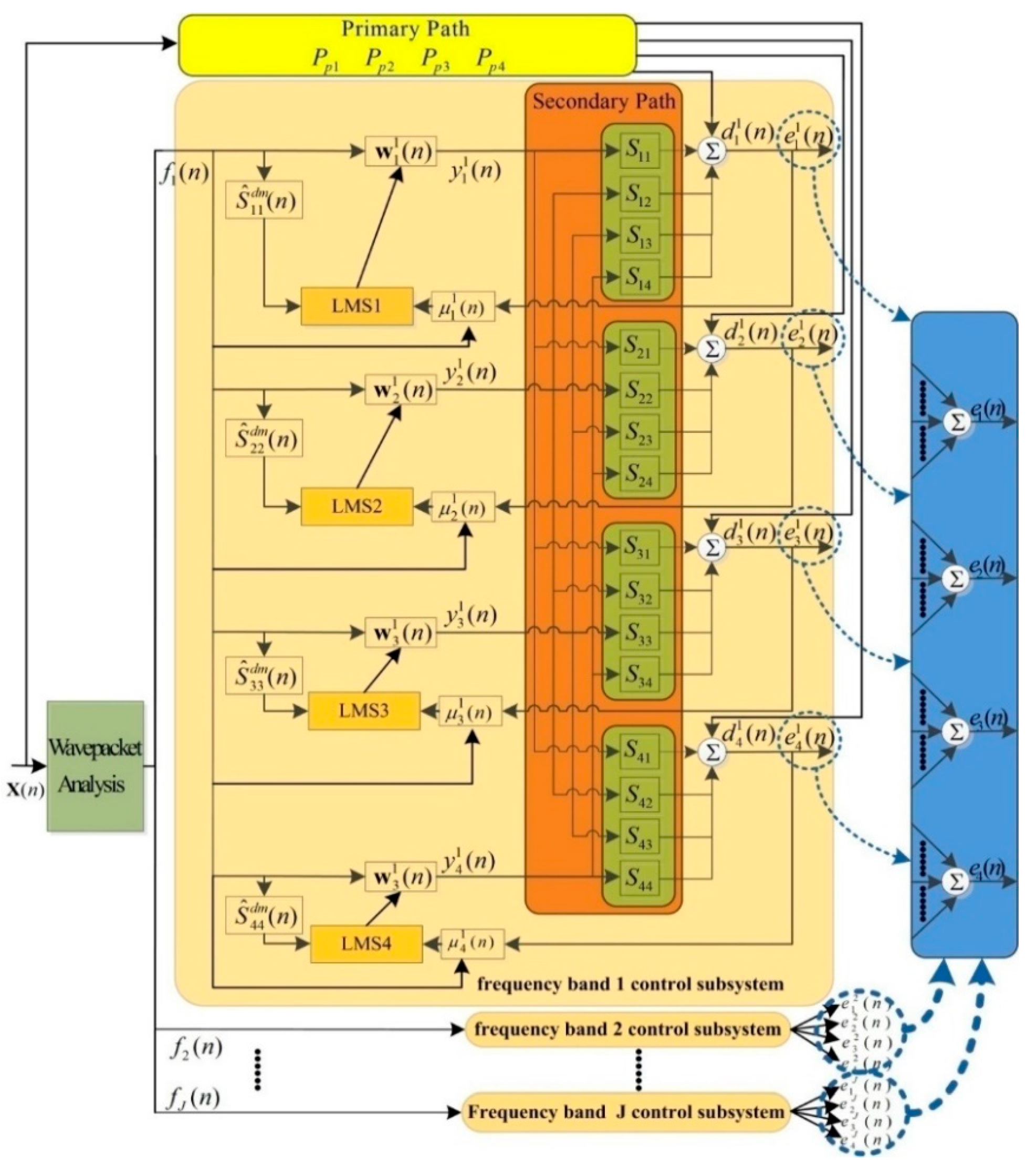






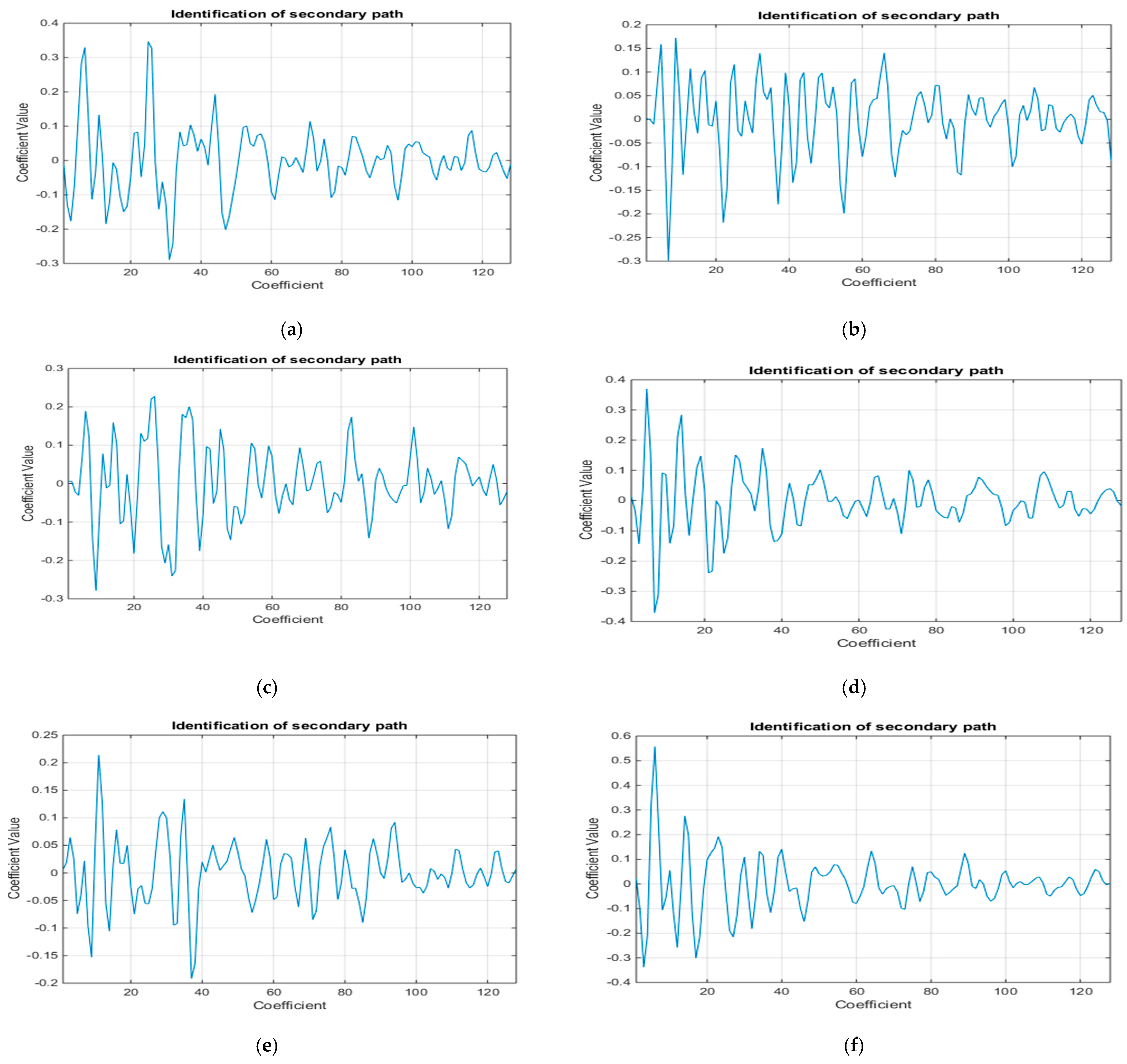
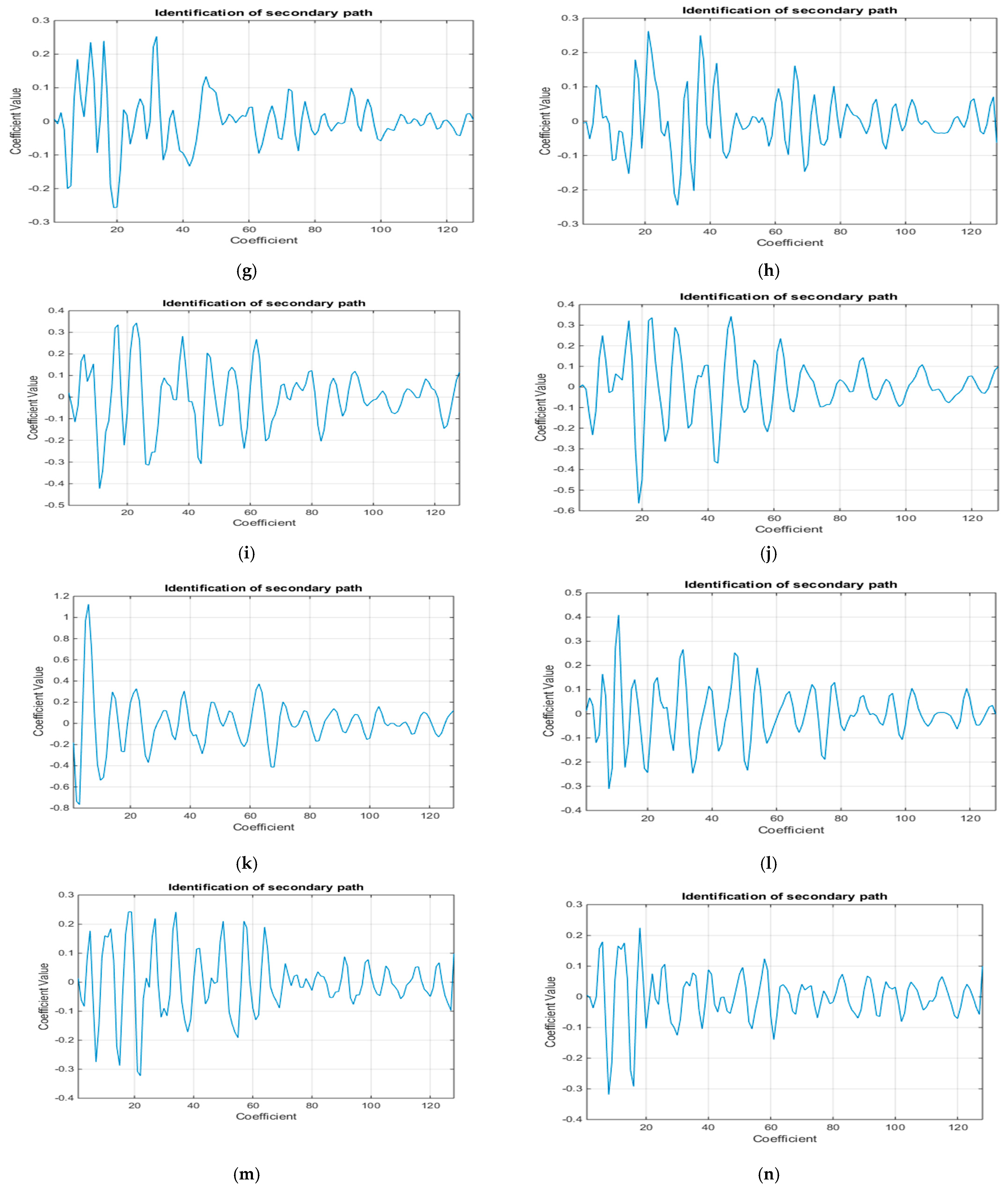





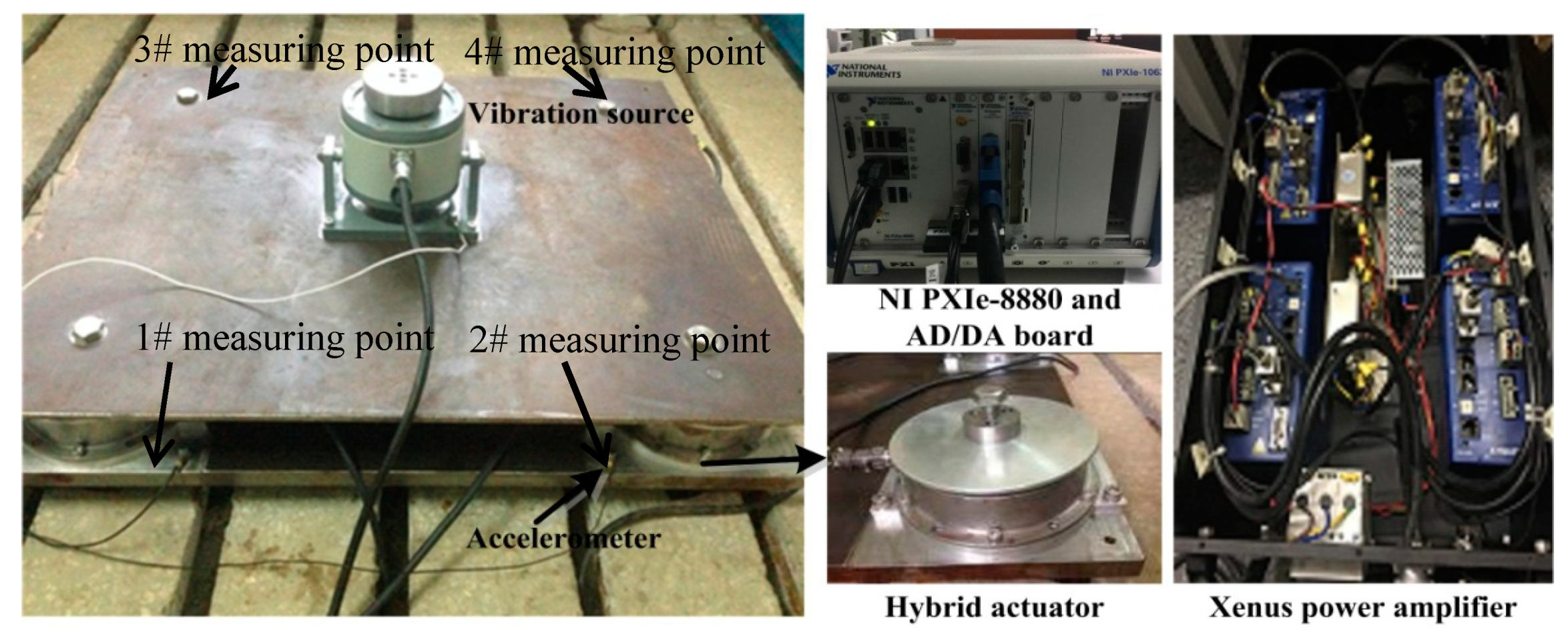
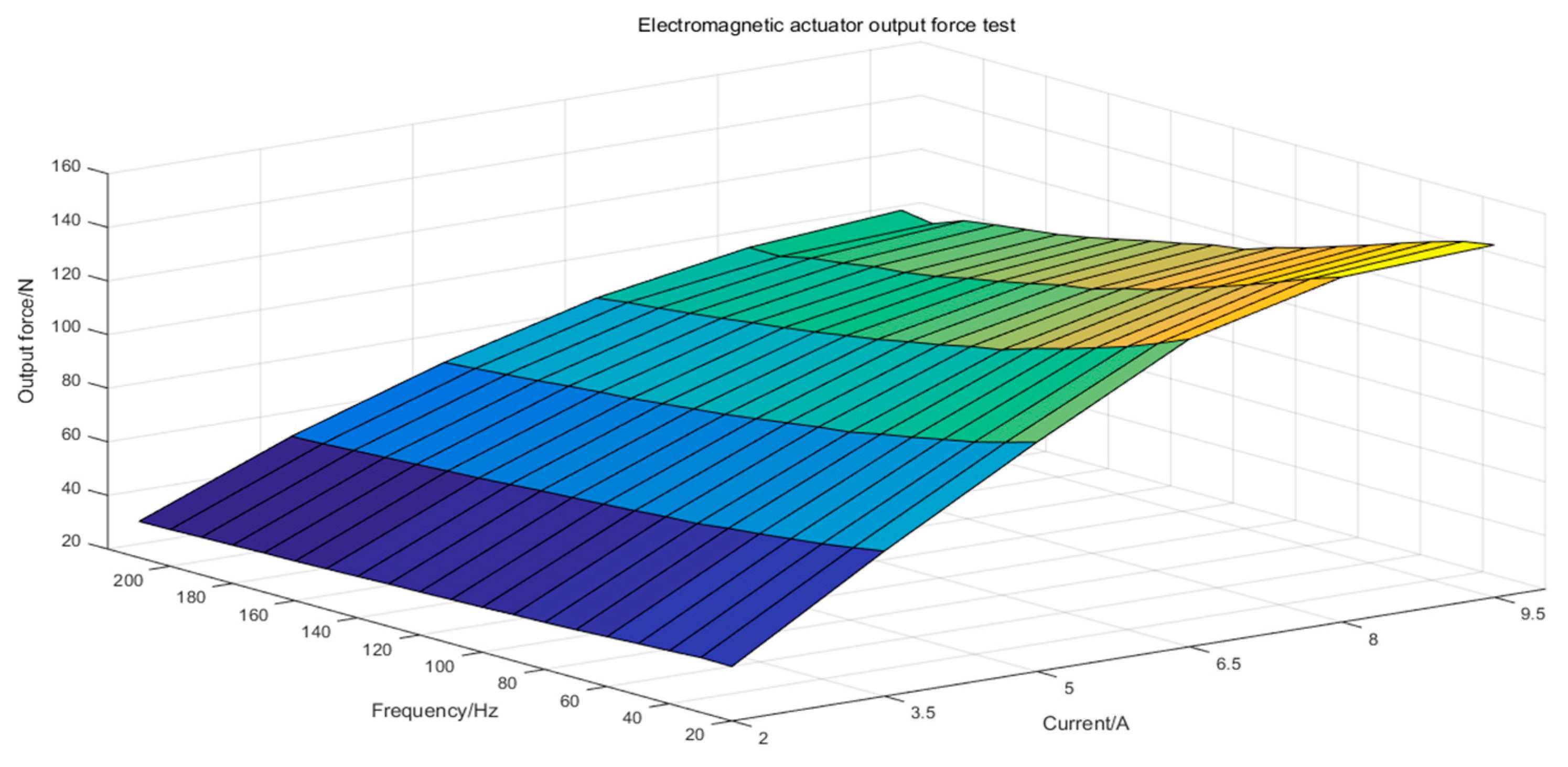




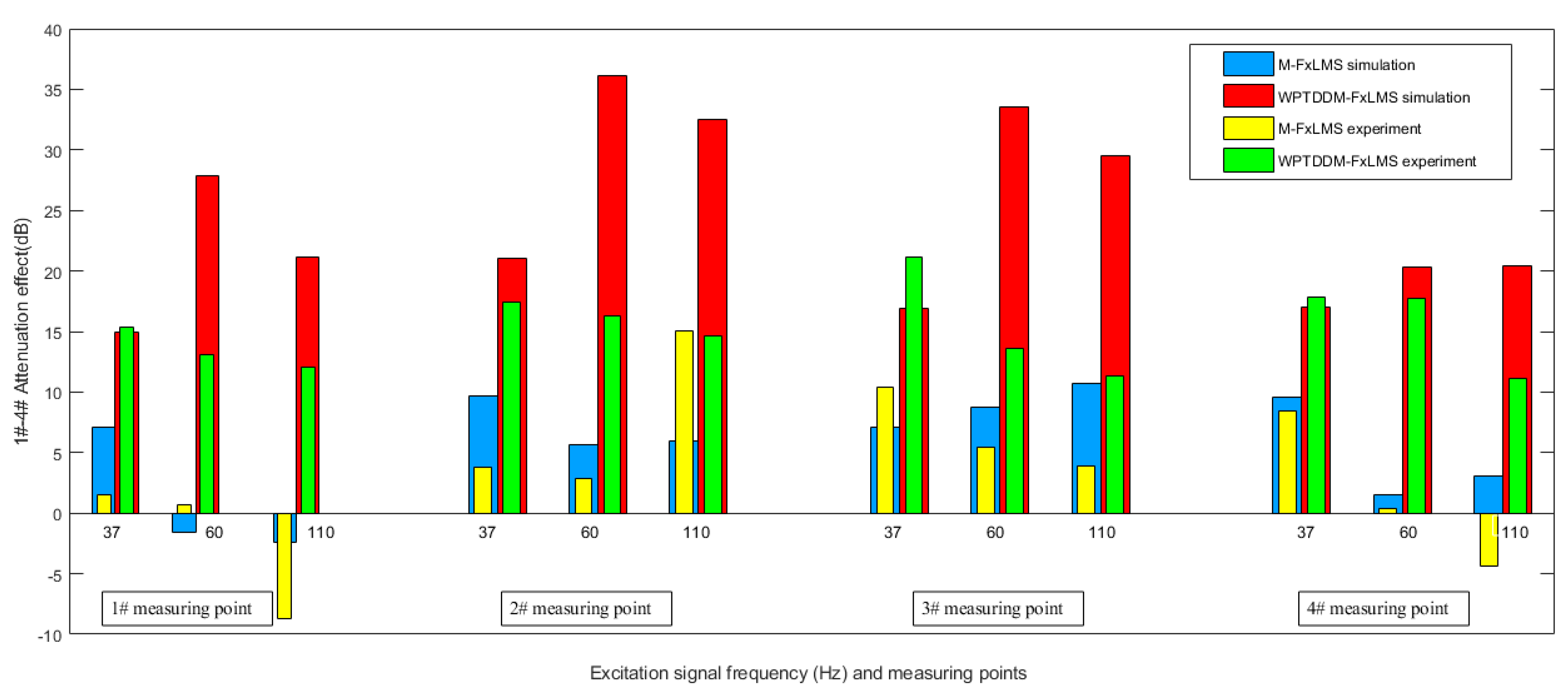
| Error Signal 1# | Error Signal 2# | |||||
| (Hz) | Passive | M-FxLMS | WPTDDM-FxLMS | Passive | M-FxLMS | WPTDDM-FxLMS |
| 37 | −14.37 | −21.51 | −29.34 | −16.32 | −26.02 | −37.37 |
| 60 | −28.34 | −26.79 | −56.20 | −25.15 | −30.85 | −61.31 |
| 110 | −39.28 | −36.91 | −60.42 | −35.60 | −41.59 | −68.12 |
| Error Signal 3# | Error Signal 4# | |||||
| (Hz) | Passive | M-FxLMS | WPTDDM-FxLMS | Passive | M-FxLMS | WPTDDM-FxLMS |
| 37 | −17.18 | −24.32 | −34.14 | −17.44 | −27.05 | −34.42 |
| 60 | −22.41 | −31.17 | −55.99 | −26.59 | −28.06 | −46.86 |
| 110 | −32.90 | −43.63 | −62.42 | −37.47 | −40.52 | −57.86 |
| Measuring Point 1# | Measuring Point 2# | |||||
| (Hz) | Passive | M-FxLMS | WPTDDM-FxLMS | Passive | M-FxLMS | WPTDDM-FxLMS |
| 37 | −1.82 | −3.38 | −17.2 | −2.18 | −5.94 | −19.59 |
| 60 | −11.12 | −11.80 | −24.25 | −11.35 | −14.21 | −27.59 |
| 110 | −12.05 | −3.36 | −24.13 | −14.26 | −29.32 | −28.92 |
| Measuring Point 3# | Measuring Point 4# | |||||
| (Hz) | Passive | M-FxLMS | WPTDDM-FxLMS | Passive | M-FxLMS | WPTDDM-FxLMS |
| 37 | −1.82 | −12.18 | −22.92 | −1.99 | −10.39 | −19.83 |
| 60 | −11.34 | −16.83 | −24.99 | −10.6 | −11.02 | −28.37 |
| 110 | −17.23 | −21.14 | −28.53 | −16.76 | −12.40 | −27.88 |
Publisher’s Note: MDPI stays neutral with regard to jurisdictional claims in published maps and institutional affiliations. |
© 2021 by the authors. Licensee MDPI, Basel, Switzerland. This article is an open access article distributed under the terms and conditions of the Creative Commons Attribution (CC BY) license (https://creativecommons.org/licenses/by/4.0/).
Share and Cite
Yang, L.; Gao, W.; Yang, J.; Zhao, B.; Liu, L. A Novel Active Control Strategy with Decentralized Decoupling and Wavelet Packet Transformation: Design and Verification. Appl. Sci. 2021, 11, 3554. https://doi.org/10.3390/app11083554
Yang L, Gao W, Yang J, Zhao B, Liu L. A Novel Active Control Strategy with Decentralized Decoupling and Wavelet Packet Transformation: Design and Verification. Applied Sciences. 2021; 11(8):3554. https://doi.org/10.3390/app11083554
Chicago/Turabian StyleYang, Lihua, Weipeng Gao, Jun Yang, Bo Zhao, and Libin Liu. 2021. "A Novel Active Control Strategy with Decentralized Decoupling and Wavelet Packet Transformation: Design and Verification" Applied Sciences 11, no. 8: 3554. https://doi.org/10.3390/app11083554






